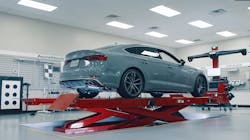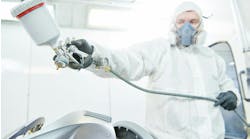The human key to static ADAS calibration accuracy
Content brought to you by Auto Body Repair Network. To subscribe, click here.
What you will learn:
•Incorrect target placement will hinder the calibration process
•Radar, Cameras, Lidar and Ultrasonic Sonar prevent pedestrian collisions
• Attention to detail is more important than experience, regarding ADAS calibration
Advanced Driver Assistance Systems (ADAS) have begun to dominate the conversation in the automotive service industry over the last few years. You can’t read an article or advertisement that doesn’t refer to ADAS in some context. The amusing thing about ADAS is that the acronym does not originate from a standard set by an authority like the EPA or Society of Automotive Engineers (SAE) but is simply a marketing term that wraps all the new safety technologies being deployed by the OEMs into an easy-to-say term.
As a 50-year veteran of the automotive mechanical space, I like to compare ADAS to OBD, or On-Board Diagnostics. OBD was standardized by SAE and CARB (California Air Resources Board) in the early 1990s, meaning there were rules set for how it should work and how technicians would engage with OBD. ADAS, on the other hand, does not contain a simple foundation standard. It contains a multitude of technologies that are designed to protect the motorist, pedestrians and other vehicles and motorists around it. Each of these technologies, such as Automated Emergency Braking, Rear Cross Traffic or Lane Keep Assist, may have standards laid out by entities such as IIHS (Insurance Institute for Highway Safety) with the goal of creating technology that prevents vehicles from running into other vehicles and, maybe more importantly, from vehicles running into pedestrians.
As automotive service professionals, when we service these technologies and calibrate them as instructed, we need to keep in mind this human aspect. We are not only dealing with a vehicle equipped with technology that might hit another vehicle if we don’t do our job correctly, but the same vehicle technology is also designed to prevent the vehicle from hitting people walking across the street, or a child darting out from between cars chasing a ball. In other words, lives are at stake and as a result, anyone servicing and/or calibrating these technologies must be trained and disciplined in their approach.
There are four primary technologies used to avoid colliding with pedestrians: Radar, Cameras, Lidar and Ultrasonic Sonar. Every collision center and most mechanical centers touch parts of the vehicle that contain these sensors every day. Depending on the service information provided by the OEM, you most likely need to calibrate the ADAS sensors after service.
A large percentage of ADAS sensors leave facilities every day in need of calibration
Of course, many of you are already doing this, so it’s no big deal, right? Well, the truth is there are a large percentage of ADAS sensors that are leaving your facilities every day in need of calibration. Some are ignored due to ignorance or because no one read the service information, while some are “calibrated” using substandard tooling or methods.
For static calibrations, it is very common to see a technician struggling with the calibration of a forward-facing camera or radar because the target is not placed in the exact right position relative to the centerline and front edge of the vehicle. The technician gets frustrated and resorts to moving the target slightly until the calibration completes. Or the shop uses inappropriately sized camera targets coupled with a modified placement position to compensate, yet if it’s calibrated with the right target positioned at the right spot, the system is found to need adjustment. When it comes to static calibrations, where a physical target must be placed in a spot relative to the vehicle, close is not good enough. Exact is the only acceptable placement option.
This article isn’t going to focus on the supplier of the target or tooling. We are assuming it is OEM or OEM-equivalent. Today, we are concerned about who is doing the calibration.
Earlier, I mentioned those performing calibrations must be trained and disciplined. That does not mean the ideal candidate is your most experienced technician. The most critical characteristics of a great ADAS calibration technician are discipline and the ability to read and follow technical information. Let’s start with reading and following technical information. The biggest downfall of most technicians who have any kind of experience in the industry at all is the discipline to read and follow technical information. They may have read the information once and followed it closely, but with ADAS, the steps and specifications can change overnight. They can’t assume the last Camry calibrates the same as the Camry in their calibration bay. Technical information is constantly being updated. ADAS processes are changing all the time with every manufacturer. Remember, ADAS is not a standard but a compilation of technologies being used in the name of safety. Standards are vetted prior to release. Many ADAS technologies are not and are deployed before the OEM fully understands how they will react or fail in the field. As the OEM learns about their systems, they update the information. So, discipline to read and follow directions on every vehicle is critical. Not skipping any part of the information is important. You can’t skip over the floor level requirements. An unlevel floor is probably the biggest sin made by shops who calibrate ADAS. Close is not level. If your house foundation was set at the same level as your shop floor, would you have bought that house? Level is level as measured with a… level. At the end of the day, how do we manage these issues profitably? Choosing the right person with the discipline to read and follow instructions is step one. Next, provide a space that meets the requirements set forth in the service information from the OEMs whose vehicles you service. Then charge appropriately. Finally, technology is available to help solve many of these issues by providing equipment that guides the technician exactly where to place a target and documents that placement relative to the vehicle. That equipment can also create a virtual level floor relative to the vehicle, making it possible to compensate for your shop’s sloping floor. Finally, training that ‘right person,” investing in their skill so they are aware of the changes and therefore seek to research the right service information will ensure that the vehicles leaving your facility will perform as they were intended.
ADAS is comprised of some amazing technology that saves lives every day, and because of that, it’s not going away anytime soon. It is important to realize that our industry has changed forever, and we must adapt with it. We can no longer afford to “do it the way we’ve always done it”. The risk is too high not to do it the right way.





